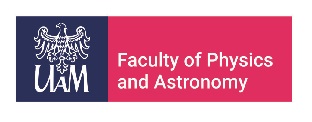
M.Sc. Emil Siuda
Department of Mesoscopic Physics
- Loc: wing J, 2nd floor, room 216
- Email: emisiu@amu.edu.pl
Scientific degrees and education
BSc in Physics – 2020
Research interests
Keywords: quantum transport, spintronics, spin Seebeck effect
Publications
2024 |
|
| 3. | Emil Siuda, Piotr Trocha Thermal generation of spin current in a quantum dot coupled to magnetic insulators Journal of Magnetism and Magnetic Materials, 589 , pp. 171495, 2024. @article{Siuda2024, title = {Thermal generation of spin current in a quantum dot coupled to magnetic insulators}, author = {Emil Siuda and Piotr Trocha}, url = {https://www.sciencedirect.com/science/article/pii/S0304885323011459}, doi = {/10.1016/j.jmmm.2023.171495}, year = {2024}, date = {2024-01-01}, journal = {Journal of Magnetism and Magnetic Materials}, volume = {589}, pages = {171495}, abstract = {In this work, we study thermally-generated spin current in the system consisting of a quantum dot connected to two magnetic insulators. The external leads are kept at different temperatures which leads to an imbalance of magnon populations in two magnetic insulators resulting in the flow of the magnon (spin) current. We take into account many-body magnon interactions and incorporate energy-dependent density of states of the magnetic insulators. Both features can strongly affect magnon distribution in the magnetic insulators and the coupling strengths between the leads and the dot, and thus, the thermally generated spin current. All the calculations are carried out in the weak coupling regime. We show, that results obtained with a density of states being a function of energy differ significantly from the ones obtained with a density of states taken as a constant. In turn, magnon interactions in the leads proved to be important at high temperatures and large values of energy of transported spin waves.}, keywords = {}, pubstate = {published}, tppubtype = {article} } In this work, we study thermally-generated spin current in the system consisting of a quantum dot connected to two magnetic insulators. The external leads are kept at different temperatures which leads to an imbalance of magnon populations in two magnetic insulators resulting in the flow of the magnon (spin) current. We take into account many-body magnon interactions and incorporate energy-dependent density of states of the magnetic insulators. Both features can strongly affect magnon distribution in the magnetic insulators and the coupling strengths between the leads and the dot, and thus, the thermally generated spin current. All the calculations are carried out in the weak coupling regime. We show, that results obtained with a density of states being a function of energy differ significantly from the ones obtained with a density of states taken as a constant. In turn, magnon interactions in the leads proved to be important at high temperatures and large values of energy of transported spin waves. |
2022 |
|
| 2. | Piotr Trocha, Emil Siuda Spin-thermoelectric effects in a quantum dot hybrid system with magnetic insulator Scientific Reports, 12 (5348), 2022. @article{Trocha2022c, title = {Spin-thermoelectric effects in a quantum dot hybrid system with magnetic insulator}, author = {Piotr Trocha and Emil Siuda}, url = {https://www.nature.com/articles/s41598-022-09105-z}, doi = {10.1038/s41598-022-09105-z}, year = {2022}, date = {2022-03-30}, journal = {Scientific Reports}, volume = {12}, number = {5348}, abstract = {We investigate spin thermoelectric properties of a hybrid system consisting of a single-level quantum dot attached to magnetic insulator and metal electrodes. Magnetic insulator is assumed to be of ferromagnetic type and is a source of magnons, whereas metallic lead is reservoir of electrons. The temperature gradient set between the magnetic insulator and metallic electrodes induces the spin current flowing through the system. The generated spin current of magnonic (electric) type is converted to electric (magnonic) spin current by means of quantum dot. Expanding spin and heat currents flowing through the system, up to linear order, we introduce basic spin thermoelectric coefficients including spin conductance, spin Seebeck and spin Peltier coefficients and heat conductance. We analyse the spin thermoelectric properties of the system in two cases: in the large ondot Coulomb repulsion limit and when these interactions are finite.}, keywords = {}, pubstate = {published}, tppubtype = {article} } We investigate spin thermoelectric properties of a hybrid system consisting of a single-level quantum dot attached to magnetic insulator and metal electrodes. Magnetic insulator is assumed to be of ferromagnetic type and is a source of magnons, whereas metallic lead is reservoir of electrons. The temperature gradient set between the magnetic insulator and metallic electrodes induces the spin current flowing through the system. The generated spin current of magnonic (electric) type is converted to electric (magnonic) spin current by means of quantum dot. Expanding spin and heat currents flowing through the system, up to linear order, we introduce basic spin thermoelectric coefficients including spin conductance, spin Seebeck and spin Peltier coefficients and heat conductance. We analyse the spin thermoelectric properties of the system in two cases: in the large ondot Coulomb repulsion limit and when these interactions are finite. |
| 1. | Piotr Trocha, Emil Siuda, Ireneusz Weymann Spin-polarized transport in quadruple quantum dots attached to ferromagnetic leads Journal of Magnetism and Magnetic Materials, 546 (168835), 2022. @article{Trocha2022b, title = {Spin-polarized transport in quadruple quantum dots attached to ferromagnetic leads}, author = {Piotr Trocha and Emil Siuda and Ireneusz Weymann}, url = {https://www.sciencedirect.com/science/article/pii/S0304885321010453}, doi = {10.1016/j.jmmm.2021.168835}, year = {2022}, date = {2022-03-15}, journal = {Journal of Magnetism and Magnetic Materials}, volume = {546}, number = {168835}, abstract = {Motivated by the experimental evidence of the Nagaoka ferromagnetism in quantum dot systems by Dehollain et al. (2020), we search for possible confirmation of such kind of ferromagnetism by analyzing the spin-resolved transport properties of a quadruple quantum dot system focusing on the linear response regime. In particular, we consider four quantum dots arranged in a two-by-two square lattice, coupled to external ferromagnetic source and drain electrodes. Turning on and off the specific conditions for the Nagaoka ferromagnetism to occur by changing the value of the intra-dot Coulomb interactions, we determine the transport coefficients, including the linear conductance, tunnel magnetoresistance and current spin polarization. We show that a sign change of the current spin polarization may be an indication of a ferromagnetic order of Nagaoka type which develops in the system.}, keywords = {}, pubstate = {published}, tppubtype = {article} } Motivated by the experimental evidence of the Nagaoka ferromagnetism in quantum dot systems by Dehollain et al. (2020), we search for possible confirmation of such kind of ferromagnetism by analyzing the spin-resolved transport properties of a quadruple quantum dot system focusing on the linear response regime. In particular, we consider four quantum dots arranged in a two-by-two square lattice, coupled to external ferromagnetic source and drain electrodes. Turning on and off the specific conditions for the Nagaoka ferromagnetism to occur by changing the value of the intra-dot Coulomb interactions, we determine the transport coefficients, including the linear conductance, tunnel magnetoresistance and current spin polarization. We show that a sign change of the current spin polarization may be an indication of a ferromagnetic order of Nagaoka type which develops in the system. |

